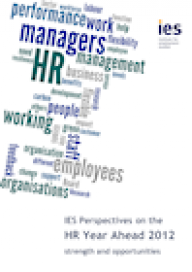Publications
 We author and publish a range of resources to keep you up to date with the latest developments in employment, labour market and human resource policy and practice.
We author and publish a range of resources to keep you up to date with the latest developments in employment, labour market and human resource policy and practice.
All our pdf publications are free to access.
Search results
-

Scoping the Development of Work and Cancer Support for SMEs
Executive Summary
Wilson S, Hicks B, Stevens H | Feb 2012 | Institute for Employment StudiesMacmillan commissioned this scoping research with small and medium-sized enterprises (SMEs) to identify the challenges particular to smaller businesses who are managing employees affected by cancer. The aim was to provide an evidence base to determine what Macmillan can do to help SMEs and how this might differ from what they currently, or plan to, offer large employers.
-

Occupational Health Advice Lines Evaluation
Final Report
Sinclair A, Martin R, Tyers C | Feb 2012 | Department for Work and Pensions (DWP)The Department for Work and Pensions launched the Occupational Health Advice Lines service in winter 2009. The service was one of a number of initiatives trialled to address the issues raised by Dame Carol Black in her review of the health of Britain’s working population and operated nationally across England, Scotland and Wales. This report presents the findings of that evaluation.
-

An assessment of the level of compliance with the statutory duty to obtain insurance under the Employers’ Liability (Compulsory Insurance) Act 1969
Sinclair A, Sumption F | Feb 2012 | Health and Safety Executive (HSE)If employees become ill or injured at work, they might be able to claim compensation from their employer. The ELCI Act (1969) requires that employers take out insurance against such claims. There are some exemptions to this, including public bodies, and those employing specified relatives only. Previous research in this area has found inconsistent levels of compliance, and some of it is quite out-of-date. This research was undertaken to provide a robust measure of levels of compliance in order to support policy development in this area.
-

Get Connected
Impact Evaluation
Aldridge F, Casey L, Lockhart-Smith A, Miller L, Oakley J, Plant H, Sterland L, Stevens H, Higgins T | Feb 2012 | National Institute of Adult Continuing Education (NIACE)The Get Connected Investment Project aimed to enable care providers to improve access for service users, carers, visitors and staff to ICT so they could use the power of the internet to communicate, learn and train. The overarching aim of the evaluation was to assess the impact of the funding on service users and staff.
-

Barristers’ Working Lives: A Biennial Survey of the Bar 2011
Pike G, Robinson D | Jan 2012 | Bar Council and Bar Standards BoardThe Bar Council, which represents barristers in England and Wales, and the Bar Standards Board, the regulator of barristers in England and Wales, commissioned IES to research and produce 'Barristers’ Working Lives', the first in a planned series of biennial surveys of the Bar. The aims of the survey were to provide improved demographic data and information on the profile of the Bar, to gather data and insights into the working lives and employment experiences of barristers and to gain a better understanding of career aspirations, motivations and intentions to stay in or leave the profession.
-

IES Perspectives on the HR Year Ahead 2012
Strength and opportunities
Dec 2011 | Institute for Employment StudiesThis report looks at opportunities for change, whilst ensuring your workforce and managers are in a strong position to embark on them.
-

Leadership and worker involvement on the Olympic Park
Lucy D, Tamkin P, Tyers C, Hicks B | Sep 2011 | Health and Safety ExecutiveThe HSE commissioned this research into leadership and worker involvement across projects on the Olympic Park to understand the degree to which approaches impacted positively or negatively and could be transferable to other construction projects and industries. This research project sought to explore the range of initiatives and approaches used, their impact on worker involvement, attitudes and behaviours, and other desired outcomes and the context in which they were effective or ineffective.
-

Evaluation of the Duty to Manage Asbestos
Sinclair A, Tyers C, Hunt W, Oakley J, Pearmain D, Savage J, Bust P, Gibb A | Aug 2011 | Health and Safety Executive (HSE)This research evaluates the impact of the Duty to Manage asbestos in non-domestic premises. It aims to: establish levels of compliance with the Duty; establish the extent to which compliance by dutyholders has brought about improved work practices among maintenance workers; re-assess the assumptions made in the Regulatory Impact Assessment (RIA) which accompanied the introduction of the Regulations about costs/benefits of the duty; identify/investigate factors influencing dutyholders' compliance with the Duty and examine any barriers to compliance; and determine the proportion of non-domestic and domestic rented premises which contain asbestos and the rate at which this is being removed.
-

Volunteering: Supporting transitions
Newton B, Oakley J, Pollard E | Apr 2011 | v inspiredIn Autumn 2010, v commissioned the Institute for Employment Studies to explore the unique contribution of volunteering to the development of employability skills and attributes, networks and contacts, qualifications and accreditation, and the relief of the negative consequences of unemployment or inactivity.
-
📄
Impact of interfirm relationships – employment and working conditions: A literature review
Martin R, Marchington M, Grimshaw D, Hadjivassiliou K, Cox A | Apr 2011 | European Foundation for the Improvement of Living and Working ConditionsThis literature review aims both to provide an up-to-date synthesis of, and contribute to, the relevant debates by analysing the varied effects of five types of interfirm relationships: public-private partnerships (PPPs), joint ventures, strategic alliances, clusters and virtual company networks (VCNs). The review uses existing literature to illustrate likely effects of each type of relationship on employment practices and working conditions.
